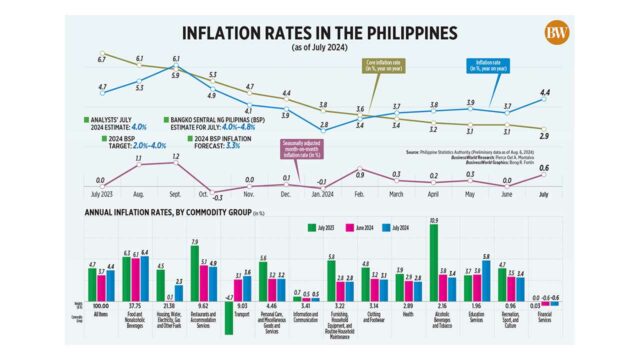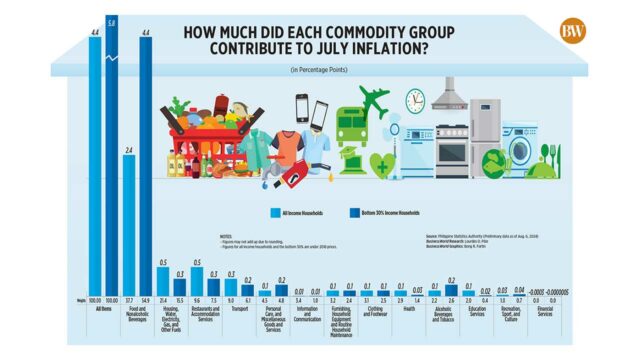Gov’t fully awards T-bonds amid robust demand
THE GOVERNMENT made a full award of the reissued seven-year Treasury bonds (T-bonds) it offered on Tuesday amid strong demand and even as rates fetched were higher than market expectations as headline inflation picked up in July, which may cause the central bank to hold off on its planned policy easing.
The Bureau of the Treasury (BTr) raised P30 billion as planned via the reissued seven-year T-bonds it auctioned off on Tuesday as total bids reached P73.079 billion, or more than double the amount on the auction block.
This brought the total outstanding volume for the series to P189.7 billion, the Treasury said in a statement.
The bonds, which have a remaining life of four years and nine months, were awarded at an average rate of 6.107%. Accepted yields ranged from 6.05% to 6.128%.
The average rate of the reissued papers dropped by 29.9 basis points (bps) from the 6.406% fetched for the series’ last award on July 2, and was also 39.3 bps lower than the 6.5% coupon for the issue.
This was also 0.8 bp lower than the 6.115% seen for the same bond series but 5.4 bps above the 6.053% quoted for the five-year bond, the tenor closest to the remaining life of the papers on offer, at the secondary market before Tuesday’s auction, based on PHP Bloomberg Valuation Service Reference Rates data provided by the BTr.
The Treasury fully awarded its bond offer on Tuesday amid robust demand, a trader said in a text message, but noted that the average yield was at the higher end of the expected range amid the faster-than-expected July headline inflation figure.
“The fact that this offer was still 2.44 times oversubscribed shows that market is already comfortable with the current levels, confident about the BSP’s (Bangko Sentral ng Pilipinas) inflation forecast, and most probably looking forward to potential number of cuts ahead,” the trader added.
“The higher-than-expected inflation data could reduce the possibility of a local policy rate cut on Aug. 15, as signaled by local monetary authorities lately,” Rizal Commercial Banking Corp. Chief Economist Michael L. Ricafort said in a Viber message.
Headline inflation accelerated to a nine-month high of 4.4% in July from 3.7% in June, the Philippine Statistics Authority reported on Tuesday.
This was slower than the 4.7% print in the same month a year ago and was within the BSP’s 4%-4.8% forecast for the month. However, this was higher than the 4% median estimate in a BusinessWorld poll of 15 analysts conducted last week and was the fastest in nine months or since the 4.9% clip in October 2023.
The July consumer price index (CPI) marked the first time since November that headline inflation exceeded the central bank’s 2-4% annual target.
For the first seven months, the CPI averaged 3.7%, above the BSP’s 3.3% forecast for the year.
The central bank is now “less likely” to cut rates at its policy meeting next week following the worse-than-expected July inflation print, BSP Governor Eli M. Remolona, Jr. said on Tuesday.
Mr. Remolona said a rate cut at its Aug. 15 review is “a little bit less likely” due to the elevated July CPI.
“That 4.4%, there is a base effect there of 0.3 percentage point. Without the base effect, it’s really 4.1%, which is still worse than expected but not that bad because it only slightly breached the ceiling,” he said.
Asked if the BSP will likely hold rates steady, Mr. Remolona said: “We are not sure because there is still a lot of data we are looking at… If growth is unexpectedly weak, then it looks like our projections of inflation and inflation expectations suggest lower inflation going forward. Then we can cut.”
Second-quarter gross domestic product data will be released on Aug. 8 (Thursday).
The BSP chief earlier signaled that they were on track to cut rates for the first time in over three years this month, possibly by 25 bps, adding that another 25-bp cut is likely next quarter.
The Monetary Board in July kept its policy rate at a 17-year high of 6.5% for a sixth straight meeting. It raised borrowing costs by a cumulative 450 bps from May 2022 to October 2023 to help tame elevated inflation.
The BTr is looking to raise P220 billion from the domestic market in August, or P80 billion from Treasury bills and P140 billion via T-bonds.
The government borrows from local and foreign sources to help fund its budget deficit, which is capped at P1.48 trillion or 5.6% of gross domestic product for this year. — AMCS




















